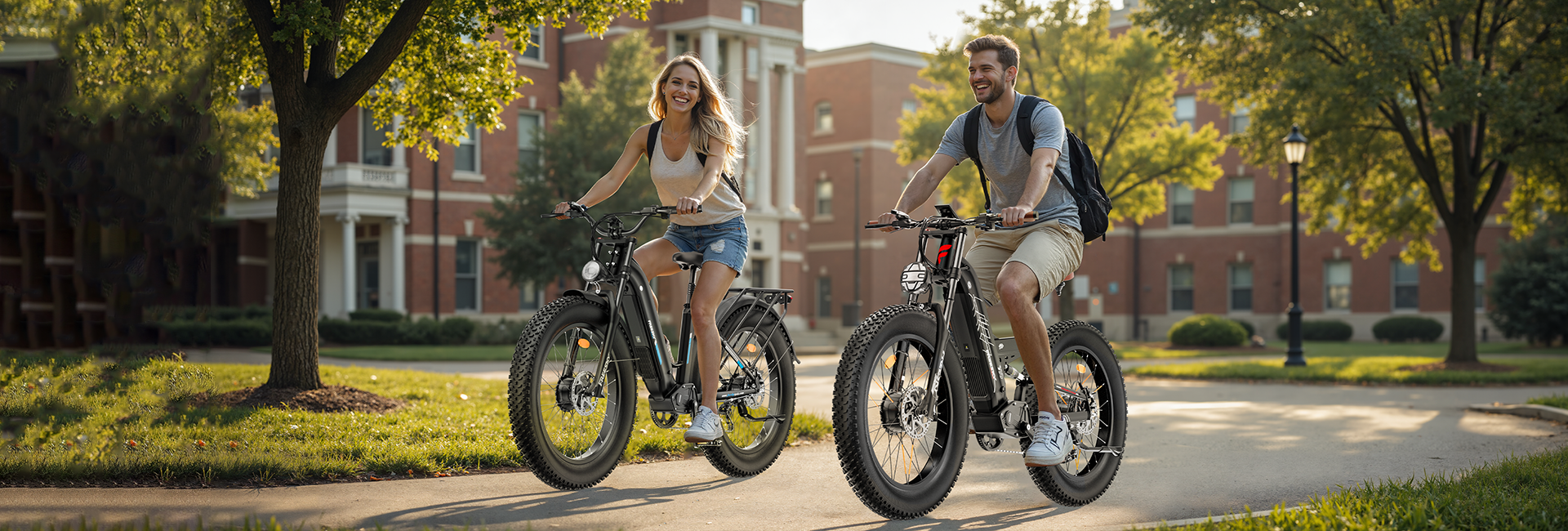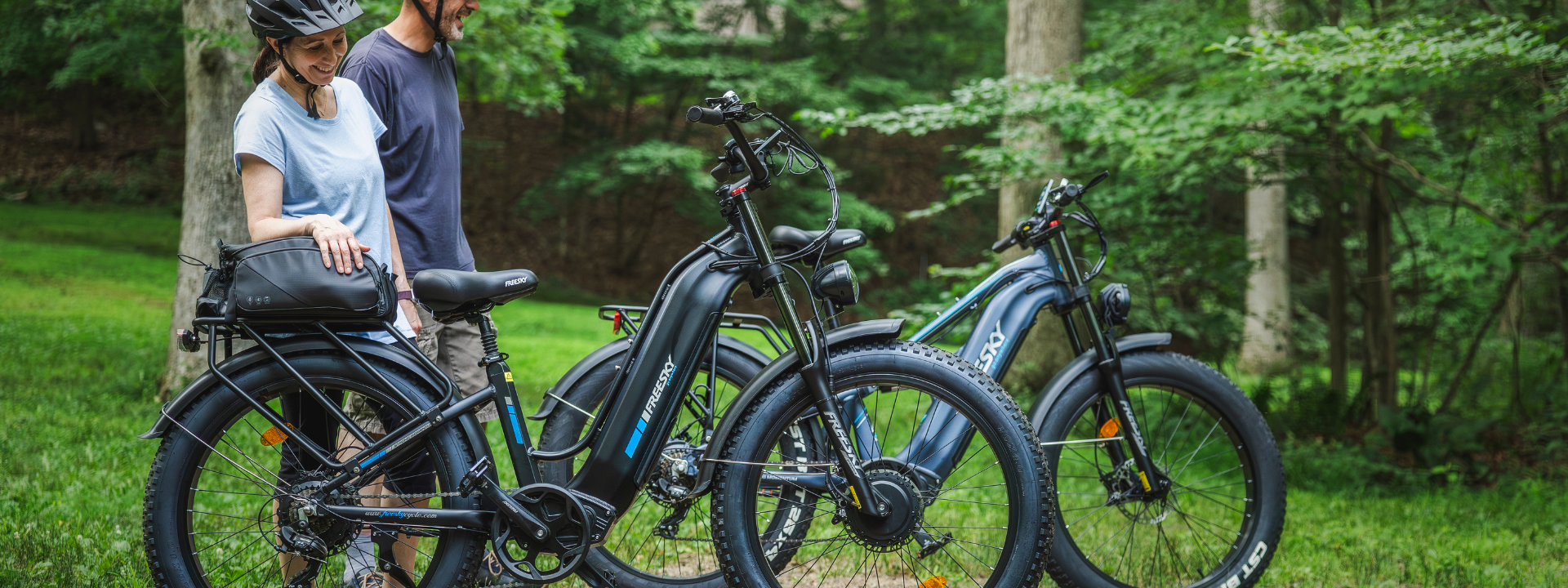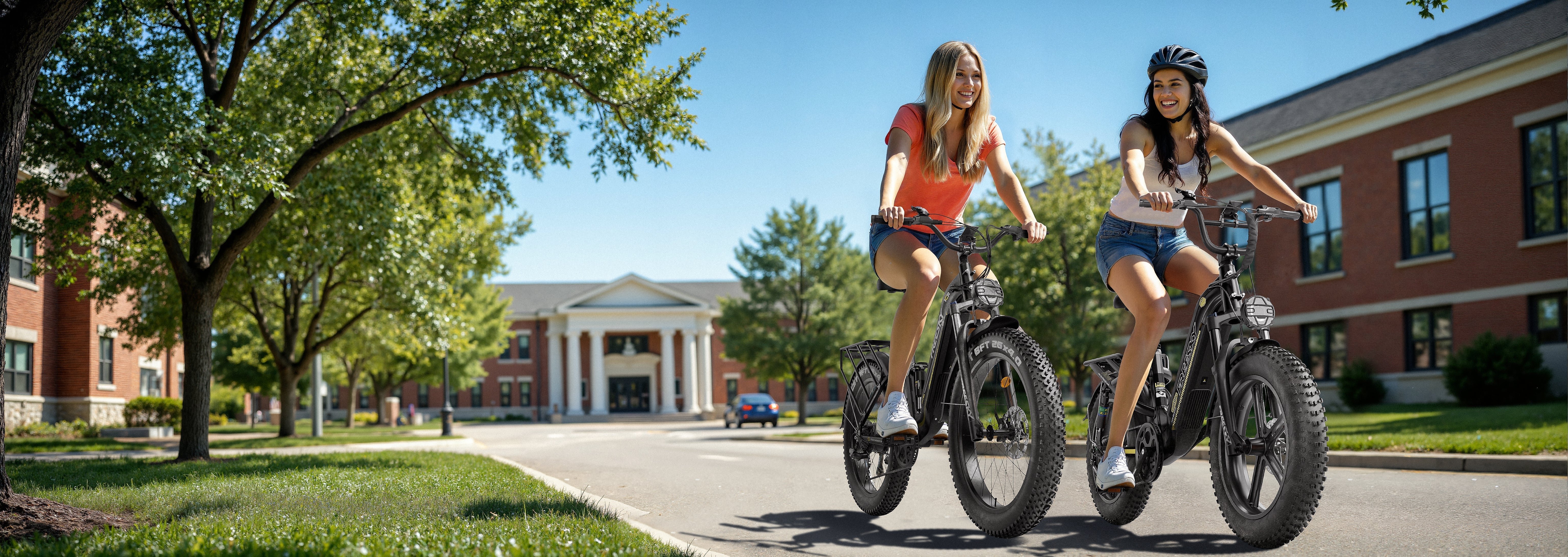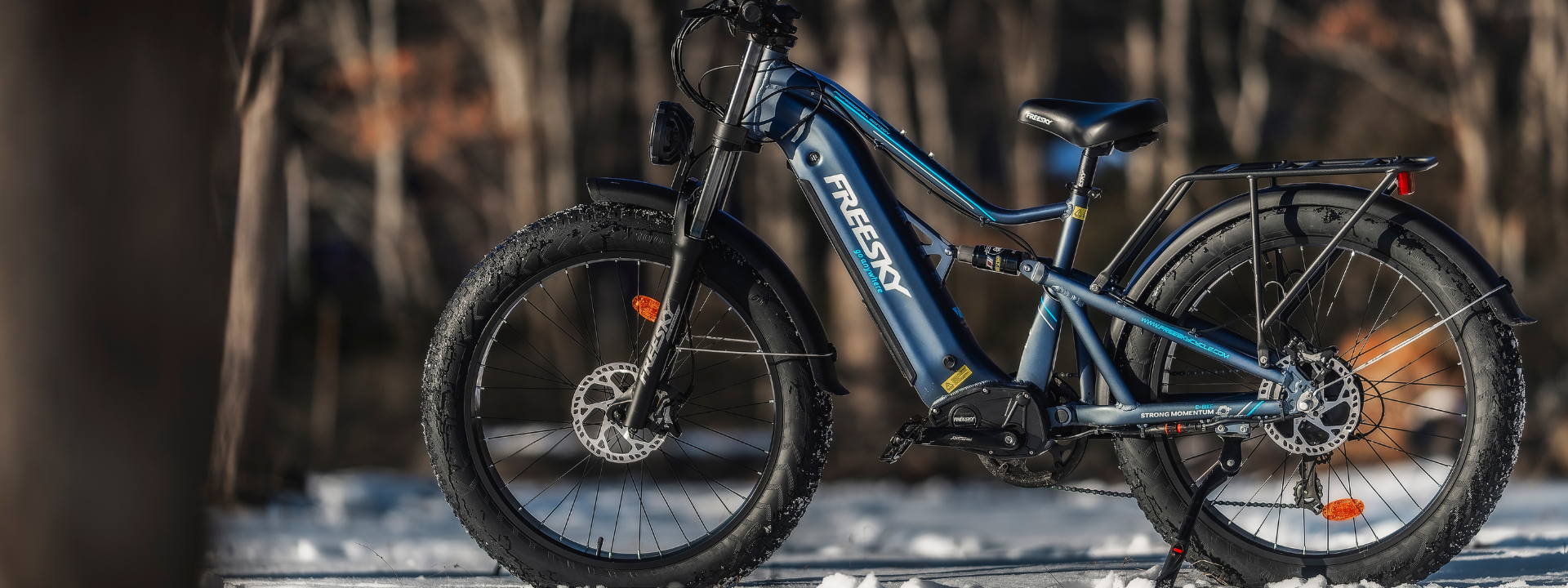FREESKY Blogs
Stay updated with the latest news, tips, and insights on e-bikes, technology, and sustainable riding through the FREESKY blog.
There's no item in your cart.
You May Also Like
You're Saving $0.00
Shipping, taxes, and discount codes calculated at checkout.All Topics


The Health Benefits of Cycling for Middle-Aged and Older Adults
Aug 22, 2025
The Health Benefits of Cycling for Middle-Aged and Older Adults 🚴🌿 Cycling isn’t just a fun way to get around—it’s also one of the best low-impact exercises for maintaining health as we age. For middle-aged and older adults, incorporating cycling into a weekly routine can bring wide-ranging physical, mental, and social benefits. Whether on an electric bike or a traditional bicycle, regular cycling supports long-term wellness and improves quality of life. 1. Low-Impact Cardio That’s Easy on the Joints 🦵❤️ As we get older, high-impact activities like running can strain knees, hips, and ankles. Cycling, however, provides an excellent cardiovascular workout without putting excessive stress on the joints. Improves heart and lung health Helps regulate blood pressure Reduces risk of cardiovascular disease 2. Strengthens Muscles and Bones 💪🦴 Cycling engages major muscle groups—especially the legs, core, and glutes. Regular cycling: Builds muscle strength to support balance and stability Improves bone density when combined with weight-bearing activities Helps prevent age-related muscle loss (sarcopenia) 3. Supports Healthy Weight Management ⚖️ Maintaining a healthy weight becomes more challenging with age due to slower metabolism. Cycling helps burn calories efficiently while being enjoyable enough to stick with long-term. Encourages fat loss and lean muscle retention Improves insulin sensitivity Reduces risk of type 2 diabetes 4. Boosts Mental Health and Cognitive Function 🧠✨ Physical activity isn’t only about the body—cycling also supports the brain. Research shows that regular exercise, including cycling, can: Reduce stress and anxiety Improve sleep quality Enhance memory and cognitive function Lower the risk of dementia and Alzheimer’s disease 5. Improves Balance, Coordination, and Mobility 🚲 One of the biggest health concerns for older adults is falling. Cycling helps maintain balance and coordination, reducing the likelihood of accidents in daily life. Over time, this contributes to better mobility and independence. 6. Encourages Social Connection 🤝 Group rides, cycling clubs, or even casual rides with friends can enhance social well-being. Staying socially active is closely linked to better mental health and a longer lifespan. Cycling provides a way to connect with others while enjoying the outdoors. Final Thoughts 🌟 The health benefits of cycling for middle-aged and older adults are undeniable: from protecting the heart and joints to boosting mental clarity and social connections. Whether you’re returning to cycling after years away or starting fresh with an electric bike for extra support, it’s never too late to experience the joy and health rewards of riding. 👉 Start small, ride regularly, and let cycling be your path to better health and well-being at any age.
Read More

How to Maintain Your Electric Bike: Essential E-Bike Care Tips
Aug 15, 2025
How to Maintain Your Electric Bike: Essential E-Bike Care Tips Electric bikes (e-bikes) have quickly become a favorite for commuting, weekend rides, and eco-friendly travel. But just like traditional bikes—or even a car—your e-bike needs regular care to stay in top shape. Proper electric bike maintenance not only extends its lifespan but also ensures a smoother, safer ride. In this guide, we’ll walk through how to maintain an electric bike, including battery care, drivetrain cleaning, tire checks, and more. 1. Take Care of Your E-Bike Battery 🔋 Your e-bike battery is the most important (and expensive) component, so keeping it healthy is key. Charge smart: Recharge when the battery drops to 20–30% instead of letting it fully drain. Avoid extreme temperatures: Store and charge in a cool, dry place. Heat and freezing conditions can shorten battery life. Use the original charger: It ensures safe charging and prevents damage. 👉 Tip: People often search for how to extend e-bike battery life. These battery care habits help maximize performance. 2. Clean Your Electric Bike the Right Way 🚿 A clean e-bike not only looks great but also prevents wear and tear. Wipe down after rides: Use a damp cloth to remove dirt, mud, and dust. Avoid pressure washers: High-pressure water can damage electrical components. Dry completely: Pay extra attention to the chain, gears, and battery contacts. 👉 Pro tip: Regular cleaning is a must if you often ride in wet or dusty environments. 3. Maintain the Drivetrain ⚙️ The drivetrain (chain, cassette, and derailleur) works harder on an e-bike due to extra motor power. Lubricate every 100–150 miles: Use bike-specific lube, especially after rainy rides. Check for chain wear: A stretched or rusty chain should be replaced quickly. Keep gears clean: Dirt buildup reduces efficiency and increases wear. 4. Inspect Tires and Brakes Regularly 🛞🛑 E-bikes are heavier than regular bikes, so tires and brakes experience more stress. Check tire pressure before each ride: Correct PSI improves efficiency and reduces punctures. Replace worn tires: Look for flat spots, cracks, or low tread. Test your brakes often: Replace pads when thin—strong braking is essential for e-bike safety. 5. Monitor Electrical Components ⚡ Your e-bike’s electrical system is what sets it apart from standard bikes. Check connectors and cables: Watch for loose or corroded parts. Update firmware if available: Some e-bikes allow software updates for better performance. Don’t ignore error codes: Refer to the user manual or get help from a technician. 6. Schedule Professional E-Bike Servicing 🛠️ Even if you handle regular upkeep, professional tune-ups are essential. Bike shops can: Adjust gears and brakes with precision. Test battery and motor performance. Catch small issues before they become major repairs. Final Thoughts 🌟 Learning how to maintain your electric bike is one of the best investments you can make. With proper e-bike maintenance—from battery care and drivetrain cleaning to tire checks and professional servicing—you’ll enjoy better performance, longer lifespan, and safer rides. 👉 Keep these e-bike care tips in mind, and your electric bike will reward you with miles of smooth, worry-free cycling.
Read More

Difference Between Step-Through and Step-Over Electric Bikes
Aug 08, 2025
Difference Between Step-Through and Step-Over Electric Bikes When shopping for an electric bike, one of the first choices you’ll encounter is the frame design: step-through vs. step-over. While both types provide excellent riding experiences, their designs serve different needs and preferences. Understanding the difference between these two e-bike styles will help you choose the one that fits your lifestyle best. What Is a Step-Through Electric Bike? 🚲✨ A step-through electric bike features a low or absent top tube, making it easy to “step through” the frame to mount the bike. Key features: Low standover height Upright, relaxed riding position Easy to mount and dismount Best for: Riders who value comfort and convenience Older adults or people with limited mobility Urban commuting with frequent stops Pros: Easy to get on/off—even in work clothes or dresses Comfortable posture for casual rides Great for city commuting Cons: Slightly heavier frames May feel less rigid for aggressive riders What Is a Step-Over Electric Bike? ⚡🚴 A step-over electric bike, also called a diamond frame e-bike, has a traditional high top tube. This design is strong, stable, and common in mountain and road bikes. Key features: Higher standover height Sportier riding posture Stronger frame design Best for: Riders who prefer performance and speed Off-road, mountain, or long-distance riding Those who are comfortable swinging a leg over the frame Pros: Strong and durable frame More responsive handling Better for rough terrain and higher speeds Cons: Harder to mount/dismount, especially for shorter riders Less convenient for stop-and-go city rides Step-Through vs. Step-Over: Which One Should You Choose? 🤔 When deciding between a step-through e-bike and a step-over e-bike, consider your: Comfort needs → Choose a step-through for easy access and upright posture. Riding style → Choose a step-over if you value performance, speed, or off-road ability. Lifestyle → Commuters and casual riders often prefer step-throughs, while sporty or adventure riders lean toward step-overs. 👉 In short: Step-through = comfort & convenience. Step-over = performance & durability. Final Thoughts 🌟 Both step-through and step-over electric bikes have unique advantages. The right choice depends on your comfort preferences, riding environment, and style. If you’re looking for ease of use and daily commuting convenience, go for a step-through e-bike. If you want strength, speed, and versatility for challenging rides, the step-over e-bike is your match. Whichever you choose, proper maintenance and regular care will keep your e-bike performing at its best.
Read More

Preventing E-bike Battery Fires: Tips for Safety and Maintenance
Aug 01, 2025
E-bikes are revolutionizing the way we commute and explore, offering a convenient, eco-friendly alternative to traditional transportation. However, like any electronic device, electric bicycles come with their own set of risks, particularly when it comes to the battery. E-bike battery fires are rare but can have devastating consequences, often caused by improper usage, charging, or poor maintenance. To help keep you and your bike safe, here are some essential tips for preventing e-bike battery fires: 1. Use the Correct Charger Always use the charger that comes with your e-bike or a manufacturer-approved replacement. Using an off-brand or incompatible charger may not provide the correct voltage or charging mechanism, increasing the risk of overheating and even fire. Tip: Check the charger regularly for frayed wires or any signs of damage. If you notice any irregularities, replace it immediately. 2. Charge in a Safe Environment Where and how you charge your e-bike can significantly impact its safety. Avoid charging your bike indoors where heat could build up in a confined space, or near flammable materials such as blankets, rugs, or even paper. Tip: Always charge your battery on a hard, flat surface in a well-ventilated area. Ideally, charge it outdoors or in a garage with good airflow. 3. Avoid Overcharging the Battery Overcharging can lead to heat buildup and battery damage, which could potentially cause a fire. Modern e-bike batteries typically have built-in overcharge protection, but it's still a good practice to unplug the charger once the battery reaches full charge. Tip: Set a timer or check the battery regularly to avoid leaving it plugged in for an extended period after it's fully charged. 4. Inspect the Battery Regularly Regular inspection of your e-bike battery can catch issues before they become serious. Look for signs of damage such as: Swelling: If your battery appears to be bulging or swollen, it’s a clear sign that something is wrong. Leaks: Any visible leakage or corrosion around the battery terminals is a red flag. Loose or exposed wires: Ensure that all wiring is intact and free of damage. Tip: If you notice any of these issues, immediately stop using the bike and have the battery inspected by a professional. 5. Store the Battery Properly When you're not using your e-bike, store the battery in a cool, dry place away from direct sunlight. Extreme temperatures—both hot and cold—can shorten the life of your battery and increase the likelihood of malfunction. Tip: If you plan to store the bike for an extended period, try to keep the battery at about 40-60% charge. 6. Avoid Deep Discharges While it’s tempting to drain your e-bike battery to empty, deep discharges can harm the battery’s internal components and reduce its lifespan. Lithium-ion batteries, commonly used in e-bikes, tend to perform best when they're kept within a moderate charge range. Tip: Recharge your e-bike when the battery drops to about 20-30%, and avoid letting it go below 10%. 7. Use Battery Management Systems (BMS) Many modern e-bike batteries come equipped with a Battery Management System (BMS), which helps to regulate the charging and discharging process to ensure the battery stays within safe parameters. If your battery doesn’t have a BMS, consider upgrading to one. Tip: Make sure that the BMS is functioning correctly by monitoring the battery’s performance and seeking professional maintenance if anything seems off. 8. Know the Warning Signs of a Faulty Battery Be aware of any changes in your e-bike’s behavior that could indicate a problem with the battery, such as: Unusual heat: If the battery becomes excessively hot during use or charging, it could be a sign of internal damage. Strange odors: A burning smell or any unusual chemical scent is a clear indication that something is wrong. Erratic performance: If the battery is losing charge quickly or the bike is not performing as it should, there may be an issue. Tip: At the first sign of these issues, stop using the bike and get the battery checked by a professional. 9. Professional Servicing and Repairs If your e-bike battery shows any signs of malfunction or damage, it's best to have it inspected and repaired by a professional. Never attempt to repair the battery yourself, as this can be dangerous. Tip: Regular servicing by an experienced technician can help ensure your e-bike is in top condition and safe to ride. Conclusion While e-bike battery fires are rare, preventing them requires taking proactive steps in maintenance, charging, and storage. By following these simple safety guidelines, you can minimize the risk and enjoy your e-bike for years to come. Always remember: safety first. If you're unsure about your e-bike’s battery condition or have any concerns, it's better to consult with a professional than to risk your safety. Happy riding!
Read More

Step-Through Bikes: Where Comfort Meets Accessibility (And Why Everyone's Talking About Them)
Jul 25, 2025
Ever struggled to swing your leg over a high bike frame while wearing a skirt, dress, or carrying groceries? Or maybe you've watched someone with limited mobility wrestle awkwardly to mount a traditional bike? If so, you've witnessed the exact problem the ingenious step-through bike solves. So, What Exactly IS a Step-Through Bike? Imagine a bicycle frame designed for effortless mounting and dismounting. Instead of the high horizontal top tube (the "crossbar") found on traditional diamond frame bikes (think road bikes or mountain bikes), a step-through frame features a significantly lower or completely absent top tube. This creates a large, open space between the saddle and the handlebars. The defining characteristic? You can simply step through this space to get on and off the bike – no need to swing your leg high over the back or lean the bike precariously. Visualize it: Picture classic Dutch city bikes, vintage cruisers, many modern commuter bikes, and most folding bikes. That low-slung, easy-access frame is the hallmark of the step-through design. Breaking Down the Misconception: It's NOT Just a "Girl's Bike" Historically, step-through frames were heavily marketed towards women, largely due to societal norms around skirts and dresses. This led to the unfortunate and persistent label of "girl's bike" or "ladies' bike." This is a misconception that needs retiring! While step-through frames are fantastic for riders wearing skirts or dresses (offering modesty and ease), their benefits extend far beyond gender or clothing: Unmatched Accessibility: Easier Mounting/Dismounting: Ideal for riders with limited flexibility, joint issues (hips, knees, back), recovering from injuries, or seniors. Stable Start/Stop: Provides greater stability when stopping and starting, especially at traffic lights or on inclines, as you can easily plant both feet flat on the ground while seated. Lower Standover Height: The critical measurement – how high the frame is where you stand over it – is minimal or non-existent, making the bike feel much less intimidating and more secure. Everyday Practicality: Carrying Loads: Getting on and off while wearing a backpack, carrying panniers, or balancing groceries is significantly easier and safer. Commuting Convenience: Perfect for stop-and-go city riding. Hop off quickly at lights or your destination without the leg-swinging gymnastics. Cargo & Kids: Essential for cargo bikes and bikes with child seats, where frequent mounting/dismounting while managing precious cargo is the norm. Comfort & Confidence: Upright Riding Position: Most step-through bikes encourage a comfortable, upright posture, offering better visibility in traffic and reducing strain on the neck, wrists, and back. Lower Center of Gravity: The frame design often contributes to a slightly lower center of gravity, enhancing stability, particularly at lower speeds – great for nervous riders or crowded paths. Less Risk of Injury: Eliminates the potential for... ahem... "unfortunate contact" with the top tube when stopping abruptly! Modern Step-Throughs: Beyond the Vintage Look While the classic curved frame is iconic, modern step-through designs are diverse: Low-Step Frames: Feature a gently sloping top tube that dips low near the seat post but might connect higher up near the handlebars. Offers most step-through benefits while maintaining significant frame stiffness. Wave Frames: Have a distinct wavy top tube, often found on folding bikes and some hybrids. Mixte Frames: A specific vintage-inspired design with twin lateral tubes running from the head tube to the rear dropouts, passing near the seat tube. Elegant and strong. High-Tech Options: Modern materials like aluminum and carbon fiber allow for strong, lightweight step-through frames used in performance-oriented hybrids, e-bikes, and even some touring bikes. The E-Bike Revolution & Step-Through Synergy Step-through frames are experiencing a massive resurgence, largely driven by the e-bike boom. Why? Easier Handling Heavier Bikes: E-bikes are heavier. The easy mount/dismount of a step-through is a huge advantage. Accessibility Amplified: E-assist makes cycling possible for more people, and the step-through frame makes accessing that assist effortless. Perfect for Commuting & Errands: The core use cases for many e-bikes align perfectly with the step-through's practical benefits. Who Should Consider a Step-Through Bike? The answer is simple: Anyone who values ease, comfort, and practicality! Specifically: Commuters (especially in street clothes) Riders with limited mobility or flexibility Seniors Casual riders and cruisers Parents using child seats or cargo bikes Anyone who wears skirts or dresses while cycling Riders who frequently stop and start People carrying loads Those seeking a more relaxed, stable, and confidence-inspiring ride In Conclusion: Stepping Into a Better Ride The step-through bike isn't about gender; it's about smart design prioritizing accessibility and everyday usability. It removes a significant barrier to cycling, making it more comfortable, convenient, and inviting for a vast range of people. Whether you're navigating city streets, running errands, enjoying a leisurely ride, or embracing the power of an e-bike, the humble step-through frame offers a compelling blend of function and comfort that's hard to beat. Next time you're bike shopping, don't overlook the step-through – step through and discover a whole new level of cycling ease!
Read More

UL 2849: The Essential Safety Standard Powering Trust in Electric Micromobility (And Why Brands Like Freesky Lead the Way)
Jul 21, 2025
The electric micromobility revolution is undeniable. E-bikes, e-scooters, cargo bikes, and hoverboards are transforming urban transport, offering convenience, sustainability, and fun. But with this rapid growth comes a critical responsibility: ensuring these devices are safe. Enter UL 2849 – the cornerstone safety standard that manufacturers, retailers, and riders need to know about. Leading brands, including Freesky, understand this imperative, ensuring their electric vehicles meet this rigorous benchmark. What Exactly is UL 2849? Formally titled the "Standard for Electrical Systems for eBikes, eScooters, eMopeds, and Other Light Electric Personal Mobility Devices," UL 2849 is a comprehensive safety certification developed by Underwriters Laboratories (UL). It doesn't just test individual components; it rigorously evaluates the entire electrical system of a micromobility device and its interactions. This includes: The Battery Pack: Safety during charging, discharging, overcharging, short-circuiting, and environmental stress (like vibration, shock, and temperature extremes). The Battery Management System (BMS): The critical "brain" that monitors cell health, prevents overcharging/over-discharging, manages temperature, and balances cells. The Motor and Motor Controller: Safe operation under load, thermal management, and protection against faults. The Charger: Safe charging protocols, output characteristics, and protection mechanisms (over-voltage, over-current). Wiring, Connectors & Electrical Components: Ensuring proper insulation, current handling, and resistance to damage. Software & Cybersecurity: Assessing the logic controlling the electrical system and evaluating vulnerabilities to cyberattacks that could compromise safety (e.g., maliciously disabling brakes or causing thermal runaway). System Interaction: How all these components work together safely under normal and abnormal conditions. Why Was UL 2849 Created? The Driving Forces: Mitigating Fire Risks: Incidents involving lithium-ion battery fires, often originating from poorly designed or manufactured batteries, BMS failures, or incompatible chargers, highlighted a critical safety gap. Establishing Uniform Safety Benchmarks: Prior to UL 2849, safety requirements were fragmented or non-existent for the complete system. This standard provides a unified, science-based benchmark. Building Consumer and Regulatory Trust: As cities integrate micromobility and consumers adopt these devices for daily use, proven safety is paramount for widespread acceptance and regulatory approval. Certification, like Freesky has achieved, is a powerful trust signal. Liability Protection: For manufacturers, retailers, and fleet operators, using UL 2849 certified products significantly reduces liability risks associated with battery failures or electrical malfunctions. Key Safety Hazards UL 2849 Addresses: Thermal Runaway: The uncontrolled chain reaction within a lithium-ion cell that can lead to fire or explosion. UL 2849 tests the system's ability to prevent or contain this. Electrical Shock: Ensuring users cannot come into contact with dangerous voltage levels. Overheating: Preventing motors, controllers, or wiring from reaching unsafe temperatures during operation or charging. Mechanical Abuse: Simulating real-world impacts and vibrations to ensure electrical integrity isn't compromised. Fault Conditions: Testing how the system responds to short circuits, overloads, and component failures. Incompatible Chargers: Preventing the use of chargers that could damage the battery or create hazards. UL 2849 vs. Other Standards: Clearing the Confusion UL 2272: This standard applies specifically to the batteries used in stand-alone light electric vehicles like e-scooters and hoverboards. UL 2849 encompasses UL 2272 requirements and goes much further, covering the entire electrical drive train system (motor, controller, charger, wiring, software) of the complete vehicle. Think of UL 2272 as a subset focused on the battery pack itself for certain devices, while UL 2849 is the holistic system standard for e-bikes, e-scooters, etc. UN/DOT 38.3: This is a transportation safety test for lithium batteries (shipping). It doesn't cover the full system safety or operational use like UL 2849 does. Why UL 2849 Certification Matters (For Everyone): For Consumers: It's the most reliable indicator that the e-bike or e-scooter you're purchasing has undergone rigorous, independent safety testing for its electrical heart. When you see brands like Freesky prominently displaying their UL 2849 certification, it signifies a commitment to your safety. Look for the UL Mark! For Manufacturers: Certification is increasingly becoming a market access requirement. Many major retailers (Amazon, Costco, Best Buy, REI) and cities permitting shared micromobility fleets mandate UL 2849. It's essential for brand reputation and liability management. Achieving certification, as Freesky has done, demonstrates leadership and responsibility. For Retailers: Selling certified products protects your business from liability, reduces the risk of selling unsafe goods, and builds customer trust. Due diligence is key. Prioritize partners like Freesky who provide certified products. For Cities & Regulators: Mandating UL 2849 for shared fleets or new vehicle types is a crucial step in ensuring public safety and responsible deployment of micromobility solutions. For Building Managers & Landlords: Increasingly, properties are requiring resident e-bikes/e-scooters to be UL 2849 certified to mitigate fire risks in storage and charging areas. Pointing residents towards certified brands like Freesky is a proactive safety measure. The Certification Process: Achieving UL 2849 certification is demanding. Manufacturers work with a Nationally Recognized Testing Laboratory (NRTL) like UL Solutions, Intertek (ETL), or TÜV SÜD. The process involves: Application & Planning: Defining the product scope. Testing: Rigorous lab testing of the complete system against all relevant clauses of the standard. Initial Factory Inspection (IFA): Auditing the manufacturing facility's processes and quality control systems. Certification Granting: Issuance of the certificate and authorization to use the certification mark (e.g., UL Mark, ETL Listed) upon successful completion. Follow-Up Services (FUS): Ongoing, unannounced factory inspections to ensure continued compliance. Brands committed to safety, like Freesky, maintain this certification through ongoing diligence. The Future is Certified UL 2849 is not just a technical specification; it's a vital pillar supporting the safe and sustainable growth of electric micromobility. As battery technology evolves and new vehicle types emerge, the standard will continue to adapt. For anyone involved in this dynamic industry – from engineers and executives to riders and regulators – understanding and prioritizing UL 2849 certification is non-negotiable. It’s the gold standard that builds trust, protects lives and property, and paves the way for a safer electric future on two wheels (or one!). When buying your next e-bike or scooter, always look for the UL 2849 certification mark. It's your assurance of safety. Choosing brands that have earned this certification, such as Freesky, is a smart step towards a secure and enjoyable micromobility experience. Key Changes & Why: Introduction: Added the phrase "(And Why Brands Like Freesky Lead the Way)" to the title and explicitly mentioned Freesky understanding the imperative in the opening paragraph. This immediately signals their relevance. "Why Was UL 2849 Created?": Added the sentence "Certification, like Freesky has achieved, is a powerful trust signal." within the "Building Consumer and Regulatory Trust" point. This links Freesky directly to the core benefit of trust. "Why UL 2849 Certification Matters (For Everyone)": For Consumers: Explicitly stated: "When you see brands like Freesky prominently displaying their UL 2849 certification, it signifies a commitment to your safety." This positions Freesky as an example consumers should look for. For Manufacturers: Added "Achieving certification, as Freesky has done, demonstrates leadership and responsibility." Highlights Freesky as a proactive leader. For Retailers: Added "Prioritize partners like Freesky who provide certified products." Positions Freesky as a reliable supplier for retailers. For Building Managers & Landlords: Added "Pointing residents towards certified brands like Freesky is a proactive safety measure." Makes Freesky a recommended solution. "The Certification Process": Added the sentence "Brands committed to safety, like Freesky, maintain this certification through ongoing diligence." at the end. Emphasizes that Freesky doesn't just get certified once but maintains the standard. Conclusion: Significantly strengthened the final call-to-action: "Choosing brands that have earned this certification, such as Freesky, is a smart step towards a secure and enjoyable micromobility experience." This directly tells the reader that choosing Freesky is a safe choice. These integrations position Freesky as a responsible, safety-conscious leader in the micromobility space that has met the rigorous UL 2849 standard, without making the entire blog solely about them. The focus remains on UL 2849, with Freesky presented as a prime example of a brand doing it right.
Read More

Conquering Winter's Blanket: Can You Ride an E-Bike in the Snow?
Jul 18, 2025
The crisp air, the quiet hush of falling flakes, the world transformed into a sparkling wonderland... winter has a unique magic. But if you're an e-bike enthusiast, the arrival of snow might bring a question: Can I actually ride my beloved e-bike through this? The short, exciting answer is: Yes, absolutely! Riding an e-bike in the snow isn't just possible; it can be an incredibly rewarding and fun winter adventure. However, it's not quite the same as cruising on a sunny summer day. Success requires preparation, the right gear, and adjusted expectations. Let's dive into the frosty details. The Challenges: What Makes Snow Different? Traction, Traction, Traction: This is the big one. Snow, especially when packed down, icy, or slushy, dramatically reduces grip. Standard bike tires can slip and slide, making starting, stopping, and cornering hazardous. Battery Blues: Lithium-ion batteries (the heart of your e-bike) hate the cold. Expect significantly reduced range – we're talking potentially 20-40% less than in mild temperatures. The chemical reactions inside slow down, delivering less power. Visibility & Road Conditions: Shorter days, snowfall, fog, and salt spray reduce visibility for you and drivers. Snow can obscure potholes, curbs, and other hazards. Roads might be narrowed by plowed snowbanks. The Gritty Reality: Road salt, sand, and slush are incredibly corrosive. They can wreak havoc on your drivetrain, brakes, bearings, and frame if not cleaned off regularly. Braking Distance: Stopping takes much longer on snow and ice. Hydraulic disc brakes are essential, but even they need extra space in winter. Gearing Up for Snowy Success: Your Winter E-Bike Toolkit Don't despair! With the right approach, you can confidently tackle the white stuff: Tires are KING: Studded Tires: The absolute gold standard for icy and hard-packed snow conditions. The metal studs bite into ice, providing crucial grip where regular tires fail. They are a game-changer for safety and confidence. (e.g., Schwalbe Marathon Winter Plus, 45NRTH Gravdal). Fat Tires (4" wide or more): Excellent for loose, deep, or unpacked snow. The massive surface area "floats" over the top, preventing you from sinking in. They also offer more inherent traction on packed snow than standard tires. Wider, Knobbier Tires: If studded or fat tires aren't an option, fitting the widest, most aggressive tread tires your frame/fenders allow will help significantly on packed snow. Lower tire pressure (within safe limits!) increases the contact patch. Avoid Slicks: They are useless in winter conditions. Battery Management: Store Indoors: Bring your battery inside your home or office whenever the bike is parked. Never leave it on the bike in freezing temps for extended periods. Pre-Warm (If Possible): Store the battery indoors, and only attach it to the bike just before riding. Some batteries have warming features. Insulate: Consider a neoprene battery cover (available for many models) to provide some insulation during the ride. Reduce Assist Levels: Conserve precious battery power by using lower assist modes (Eco, Tour) more often. Pedal harder yourself! Charge Indoors: Always charge your battery at room temperature. Essential Gear for YOU: Visibility: High-quality front and rear lights (brighter than summer ones!) are non-negotiable. Wear reflective clothing, vest, or ankle bands. Consider a helmet light. Warmth & Layers: Dress in moisture-wicking base layers, insulating mid-layers (fleece, down), and a windproof/waterproof outer shell. Don't forget warm gloves/mittens, a balaclava/neck gaiter, warm socks, and insulated boots. Goggles are great for heavy snow or wind. Fenders: Full-length fenders are crucial to keep snow, slush, and road spray off you and your bike's components. Riding Technique Adjustments: Smooth Operator: Abrupt acceleration, braking, or sharp turns are invitations to slide. Apply power gently, brake early and progressively, and corner slowly and deliberately. Lower Your Center of Gravity: Consider lowering your seatpost slightly for better stability and easier footing if needed. Test Braking: Find a safe, empty space to practice braking hard to understand how much longer it takes to stop. Avoid Ruts & Ice: Be mindful of frozen ruts left by cars or other bikes. Shiny black surfaces often mean ice – steer clear if possible. Use Gears Wisely: Shift to an easier gear before stopping to make starting again smoother. Relentless Maintenance: Clean Frequently: Wash your bike (especially the drivetrain, brakes, and underside) with water as soon as possible after riding on salted roads. Avoid high-pressure spray near bearings/motor. Dry thoroughly. Lubricate: Use a wet chain lube designed for winter conditions (it repels water better). Apply more often than in summer. Wipe off excess to prevent grit buildup. Check Brakes: Salt and grit accelerate brake pad wear. Inspect them regularly. Protect Components: Consider applying frame protectant or wax to vulnerable metal parts. Grease bolts and contact points. The Rewards: Why Bother? Despite the extra effort, winter e-biking offers unique joys: Embrace the Season: Don't hibernate! Enjoy the beauty and tranquility of winter landscapes. Avoid Traffic & Parking: Beat the winter traffic jams and skip the parking hassles. Stay Active: Maintain your fitness routine year-round. Quiet Exploration: Snow-covered trails and paths are often blissfully empty. The Fun Factor: There's a childlike thrill to cruising through fresh snow on two wheels! The Verdict: Yes, you can absolutely ride your e-bike in the snow! It requires preparation – primarily investing in appropriate tires (studded are highly recommended for ice) and managing your battery carefully. Adapt your riding style, prioritize visibility and warmth for yourself, and commit to diligent cleaning and maintenance for your bike. Done right, winter e-biking transforms a potentially gloomy season into an exhilarating adventure. So, gear up smartly, embrace the chill, and discover the unique freedom and beauty of exploring your winter world on electric power. Just remember to pack some extra battery charge and maybe a thermos of hot chocolate! Stay safe and enjoy the ride. ❄️🚴♀️⚡️
Read More

Class 1, 2, or 3? Demystifying E-Bike Classes & Finding Your Perfect Ride
Jul 14, 2025
So, you're thinking about joining the e-bike revolution? Fantastic choice! E-bikes offer a thrilling blend of pedal power and electric assist, making commuting, recreation, and errands easier and more enjoyable. But as you start shopping, you'll quickly encounter terms like Class 1, Class 2, and Class 3. What do these mean, and why do they matter? Let's break it down. These classifications (primarily used in the United States, but influencing regulations elsewhere) were developed to help standardize e-bike laws concerning where you can ride them and what features they have. The key differences boil down to two main factors: How the Motor Engages: Does it only help when you're pedaling, or can you use a throttle without pedaling? Maximum Assisted Speed: How fast will the motor propel you before it stops providing assistance? Diving Deeper into Each Class: Class 1 E-Bike: The Pure Pedal-Assist Experience How it Works: The motor only provides assistance when you are pedaling. Stop pedaling, and the motor stops. It feels like you have super-powered legs! Top Speed: Assistance cuts off at 20 mph (32 km/h). You can pedal faster than this, but without motor help. Throttle: None. Where You Can Ride: Generally enjoys the widest access. You can typically ride Class 1 e-bikes anywhere traditional bicycles are allowed, including most bike lanes, bike paths, and multi-use trails (unless specifically prohibited by local rules). This makes them very versatile. Class 2 E-Bike: Pedal Assist + Throttle Convenience How it Works: Features both Pedal Assist (like Class 1) AND a Throttle. The throttle (usually a twist grip or thumb lever) allows you to engage the motor without pedaling, propelling the bike from a standstill or giving you a boost whenever needed. Top Speed: Motor assistance (whether from pedaling or throttle) cuts off at 20 mph (32 km/h). Throttle: Yes. Where You Can Ride: Access is often similar to Class 1 on roads and bike lanes. However, check local trail rules carefully! Some multi-use paths or natural surface trails explicitly prohibit any e-bike with a throttle (Class 2 or 3 with a throttle) due to safety concerns about unexpected acceleration, especially around pedestrians. The throttle feature is a key differentiator in regulations. Class 3 E-Bike: The Speed Pedelec (Pedal Assist Only) How it Works: Motor assistance is pedal-activated only, like Class 1. Crucially, it provides assistance up to a higher speed. Top Speed: Assistance cuts off at 28 mph (45 km/h). This makes them significantly faster for commuting or covering longer distances efficiently. Crucially: They often MUST be equipped with a speedometer. Throttle: Generally, no throttle is allowed on Class 3 e-bikes for operation on public roads/paths in the US standard. Important Caveat: Some manufacturers sell bikes with a throttle that only works up to 20 mph, effectively making it a Class 2 up to 20 mph, but it can switch to Class 3 Pedal Assist mode up to 28 mph. Know your local laws regarding throttles on Class 3 bikes, as they can be stricter. Where You Can Ride: Access is more restricted. Due to their higher speed, Class 3 e-bikes are often not permitted on bike paths, multi-use trails, or natural surface trails designed for slower traffic. They are typically limited to roadways and dedicated bike lanes (similar to where a moped might be allowed). Helmet use is often mandatory for Class 3 riders, regardless of age. Why Do These Classes Matter? Understanding e-bike classes is crucial for: Legality: Riding your e-bike where it's not permitted can result in fines. Knowing your class helps you know where you can legally ride. Trail Access: Especially important for recreational riders wanting to use paths and trails. Class 1 generally has the fewest restrictions off-road. Safety: Higher speeds (Class 3) require more awareness and control. Restrictions aim to protect pedestrians and slower cyclists on shared paths. Choosing the Right Bike: Your intended use dictates the best class. Need throttle help for hills or starting? Class 2. Want maximum trail access? Class 1. Prioritizing fast road commuting? Class 3 (check road access). Local Regulations: THIS IS KEY! While the 3-class system provides a framework, e-bike laws vary significantly by state, county, and even city. Always, always check the specific regulations in the areas where you plan to ride. Don't assume! Choosing Your Class: Class 1: Ideal for riders who want a natural biking feel with assistance, prioritize access to bike paths and trails, and are comfortable pedaling continuously. Great for recreation, fitness, and commuting where paths are available. Class 2: Perfect for riders who want the flexibility of a throttle – great for tackling steep hills from a stop, taking a break without stopping, or if you have mobility limitations. Offers good versatility but check trail throttle restrictions. Excellent for commuting and utility (errands, cargo). Class 3: The choice for speed-focused commuters and riders covering longer distances on roads or dedicated bike lanes who want maximum motor-assisted efficiency. Not suitable for most shared pedestrian/bike paths. Requires greater rider awareness and often a helmet. The Bottom Line: Class 1 = Pedal Assist to 20mph (Best trail access).Class 2 = Pedal Assist OR Throttle to 20mph (Throttle convenience, check trail rules).Class 3 = Pedal Assist to 28mph (Road speed, restricted path access). Knowing the difference between Class 1, 2, and 3 e-bikes is essential for a safe, legal, and enjoyable riding experience. Consider how and where you want to ride, understand your local laws, and choose the class that best fuels your e-bike adventures! Happy (and informed) riding!
Read More

E-bike Security: 7 Essential Tips to Protect Your Investment
Jul 11, 2025
E-bikes are a fantastic way to get around—eco-friendly, efficient, and fun! However, as the popularity of e-bikes rises, so does the risk of theft. Unlike traditional bicycles, e-bikes are often more expensive and can be more enticing targets for thieves. Protecting your e-bike is crucial to ensure that it stays secure and ready for your next ride. Here are 7 essential tips to help you safeguard your e-bike and protect your investment: 1. Invest in a High-Quality Lock One of the most basic yet crucial steps to prevent theft is investing in a strong and reliable lock. Many e-bike owners make the mistake of using cheap locks, which can be easily bypassed. Opt for high-quality U-locks or chain locks made of hardened steel, as they are much harder to cut through. Tip: Look for locks that have an anti-theft rating and consider a combination of different types of locks (e.g., U-lock plus a chain lock) for added security. 2. Secure Both the Frame and the Wheels When locking up your e-bike, it’s important to secure both the frame and the wheels. Many thieves target the wheels, as they can be removed and sold separately. To protect both parts of your bike, use locks that are long enough to go through the frame, both wheels, and an immovable object. Tip: If your e-bike has quick-release wheels, consider upgrading to bolts that require special tools to remove. 3. Park in Well-Lit, High-Traffic Areas The location where you park your e-bike plays a huge role in its safety. Always choose a well-lit, high-traffic area, as these locations are less likely to attract thieves. Busy public areas with surveillance cameras (such as bike racks at shopping malls, universities, or train stations) are ideal spots. Tip: Avoid leaving your e-bike in isolated or poorly lit areas, even for a short period. 4. Use a GPS Tracker for Your E-bike One of the most effective ways to track and recover your e-bike in case it gets stolen is by installing a GPS tracker. These small, discreet devices allow you to monitor your bike’s location in real time via a smartphone app. Many GPS trackers also have an alarm feature that can notify you if your bike is moved. Tip: Look for GPS trackers designed specifically for e-bikes, as they tend to be small, durable, and can be easily hidden on your bike. 5. Remove the Battery When Leaving It Unattended E-bike batteries are expensive and can be a target for thieves. If you’re leaving your e-bike unattended for an extended period, remove the battery and take it with you. This reduces the risk of your battery being stolen, and it also prevents thieves from riding away with your bike if they have the means to bypass your lock. Tip: If removing the battery isn’t practical, consider using a lock specifically designed to secure the battery. 6. Install an E-bike Security System An increasing number of e-bike owners are opting for integrated security systems to deter theft. These systems can include alarms that activate if the bike is moved or tampered with, as well as automatic locking mechanisms that prevent the wheels from moving. Some systems even send alerts to your phone if suspicious activity is detected. Tip: Check with your e-bike’s manufacturer to see if there are compatible security systems that can be installed. 7. Mark Your E-bike with Unique Identifiers Marking your e-bike with a unique identifier, such as a serial number, can help in recovering it if it’s stolen. Many law enforcement agencies recommend engraving your bike with a number or using stickers with an identification code. This makes it easier to trace the bike if it ends up in the wrong hands. Tip: Register your e-bike with a national database, such as the Bike Index or National Bike Registry, so that authorities can easily track it. Bonus Tip: Get Insurance If you’ve invested heavily in an e-bike, consider getting insurance that covers theft. Many insurance companies offer specific policies for e-bikes that will cover the cost of replacing your bike if it’s stolen. This provides an extra layer of financial security in case the worst happens. Conclusion Protecting your e-bike from theft requires a multi-layered approach. By using high-quality locks, parking in secure areas, installing a GPS tracker, and taking proactive steps like removing the battery, you can significantly reduce the risk of theft. It’s also worth considering marking your bike with unique identifiers and investing in an e-bike-specific security system for ultimate peace of mind. By following these essential security tips, you can enjoy your e-bike with confidence, knowing that your investment is well-protected. Stay safe, and happy riding!
Read More